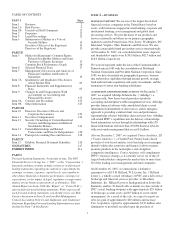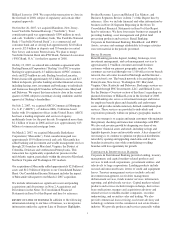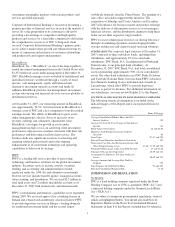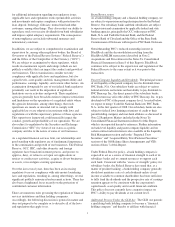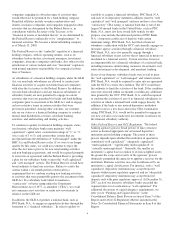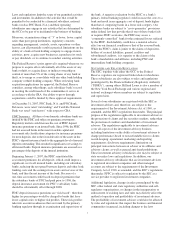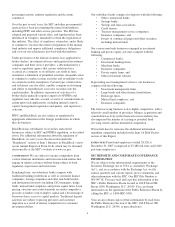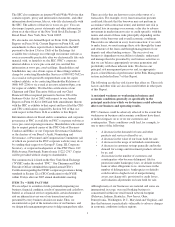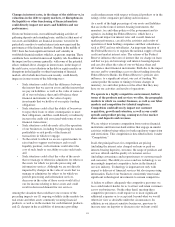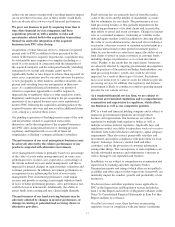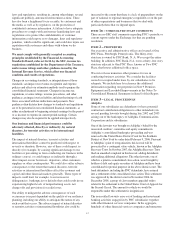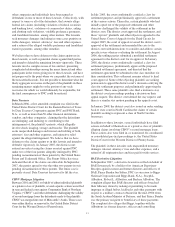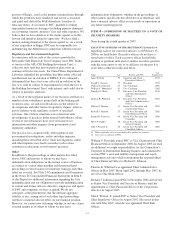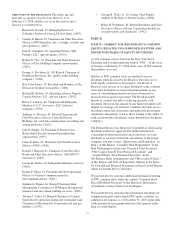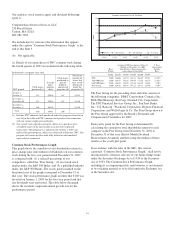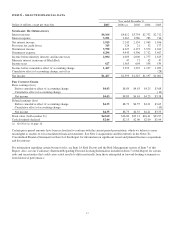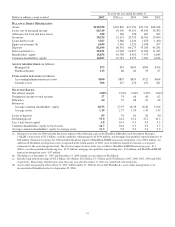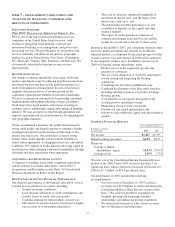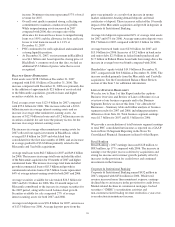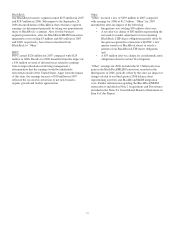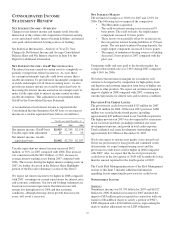PNC Bank 2007 Annual Report Download - page 17
Download and view the complete annual report
Please find page 17 of the 2007 PNC Bank annual report below. You can navigate through the pages in the report by either clicking on the pages listed below, or by using the keyword search tool below to find specific information within the annual report.laws and regulations, resulting in, among other things, several
significant publicly-announced enforcement actions. There
has also been a heightened focus recently, by customers and
the media as well as by regulators, on the protection of
confidential customer information. A failure to have adequate
procedures to comply with anti-money laundering laws and
regulations or to protect the confidentiality of customer
information could expose us to damages, fines and regulatory
penalties, which could be significant, and could also injure our
reputation with customers and others with whom we do
business.
We must comply with generally accepted accounting
principles established by the Financial Accounting
Standards Board, rules set forth by the SEC, income tax
regulations established by the Department of the Treasury,
and revenue rulings and other guidance issued by the
Internal Revenue Service, which affect our financial
condition and results of operations.
Changes in accounting standards, or interpretations of those
standards, can impact our revenue recognition and expense
policies and affect our estimation methods used to prepare the
consolidated financial statements. Changes in income tax
regulations, revenue rulings, revenue procedures, and other
guidance can impact our tax liability and alter the timing of cash
flows associated with tax deductions and payments. New
guidance often dictates how changes to standards and regulations
are to be presented in our consolidated financial statements, as
either an adjustment to beginning retained earnings for the period
or as income or expense in current period earnings. Certain
changes may also be required to be applied retrospectively.
Our business and financial performance could be
adversely affected, directly or indirectly, by natural
disasters, by terrorist activities or by international
hostilities.
The impact of natural disasters, terrorist activities and
international hostilities cannot be predicted with respect to
severity or duration. However, any of these could impact us
directly (for example, by causing significant damage to our
facilities or preventing us from conducting our business in the
ordinary course), or could impact us indirectly through a
direct impact on our borrowers, depositors, other customers,
suppliers or other counterparties. We could also suffer adverse
consequences to the extent that natural disasters, terrorist
activities or international hostilities affect the economy and
capital and other financial markets generally. These types of
impacts could lead, for example, to an increase in
delinquencies, bankruptcies or defaults that could result in our
experiencing higher levels of nonperforming assets, net
charge-offs and provisions for credit losses.
Our ability to mitigate the adverse consequences of such
occurrences is in part dependent on the quality of our resiliency
planning, including our ability to anticipate the nature of any
such event that occurs. The adverse impact of natural disasters
or terrorist activities or international hostilities also could be
increased to the extent that there is a lack of preparedness on the
part of national or regional emergency responders or on the part
of other organizations and businesses that we deal with,
particularly those that we depend upon.
ITEM
1
B
–
UNRESOLVED STAFF COMMENTS
There are no SEC staff comments regarding PNC’s periodic or
current reports under the Exchange Act that are pending
resolution.
ITEM
2–
PROPERTIES
Our executive and administrative offices are located at One
PNC Plaza, Pittsburgh, Pennsylvania. The thirty-story
structure is owned by PNC Bank, N. A. We occupy the entire
building. In addition, PNC Bank, N.A. owns a thirty-four story
structure adjacent to One PNC Plaza, known as Two PNC
Plaza, that houses additional office space.
We own or lease numerous other premises for use in
conducting business activities. We consider the facilities
owned or occupied under lease by our subsidiaries to be
adequate. We include here by reference the additional
information regarding our properties in Note 9 Premises,
Equipment and Leasehold Improvements in the Notes To
Consolidated Financial Statements in Item 8 of this Report.
ITEM
3–
LEGAL PROCEEDINGS
Adelphia
Some of our subsidiaries are defendants (or have potential
contractual contribution obligations to other defendants) in
several pending lawsuits brought during late 2002 and 2003
arising out of the bankruptcy of Adelphia Communications
Corporation and its subsidiaries.
One of the lawsuits was brought on Adelphia’s behalf by the
unsecured creditors’ committee and equity committee in
Adelphia’s consolidated bankruptcy proceeding and was
removed to the United States District Court for the Southern
District of New York by order dated February 9, 2006. Pursuant
to Adelphia’s plan of reorganization, this lawsuit will be
prosecuted by a contingent value vehicle, known as the Adelphia
Recovery Trust. In October 2007, the Adelphia Recovery Trust
filed an amended complaint in this lawsuit, adding defendants
and making additional allegations. The other lawsuits, one of
which is a putative consolidated class action, were brought by
holders of debt and equity securities of Adelphia and have been
consolidated for pretrial purposes in the above district court. The
bank defendants, including the PNC defendants, have entered
into a settlement of the consolidated class action. This settlement
was approved by the district court in November 2006. In
December 2006, a group of class members appealed orders
related to the settlement to the United States Court of Appeals for
the Second Circuit. The amount for which we would be
responsible under this settlement is insignificant.
The non-settled lawsuits arise out of lending and investment
banking activities engaged in by PNC subsidiaries together
with other financial services companies. In the aggregate,
hundreds of other financial services companies and numerous
12


